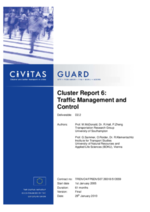Creating a traffic visualisation system
Thematic areas
Smart, Sustainable, Connected and Shared mobility
- Connected and automated transport
- Real-time road-user information
- ITS-based enhancement of public transport
- ITS for traffic
Summary
The main goal of the measure was to upgrade and modernise the traffic control centre, display panels and all other traffic monitoring and control systems in order to achieve qualitative improvements in traffic management.
Implementing sustainable mobility
Prior to the measure implementation, traffic monitoring and control were carried out using a synoptic panel system comprising various screens in a control room and various video cameras in the most strategic streets. Traffic lights had been regulated from the control room for over 10 years, but the system was unable to respond to present-day needs due to the rapid expansion of the city towards new peripheral zones. As a consequence, traffic monitoring and control were limited to the urban centre and did not cover current traffic flows, new avenues and vehicles travelling on the principal access roads. Upgraded traffic monitoring and control facilities were also required because of the creation of new ring roads.
Progress
Under the CARAVEL project, the video surveillance of traffic flows was optimised by the introduction of a new system. Areas under surveillance feed traffic information to the control centre, where traffic conditions are displayed on a plasma screen. A technical study was undertaken to identify ways to integrate information captured on camera and supply it in real time to the control centre and from there to the electronic displays located around the city. At the control centre, traffic flows are visualised using high-resolution graphic images obtained via local access networks using projection technology and graphic controllers.
The traffic information system includes the integration of cleaner and more sustainable urban transport, ensuring that members of the public are kept informed of all transport options as they arise. As part of the modernisation and refurbishment measures, improvements were made to traffic light controls, dynamic information panels, panels indicating free parking spaces in public car parks, traffic monitoring cameras and access controls in pedestrian areas.
Outcomes
Congestion had been reduced by the end of the project and more than 87 percent of citizens were aware of the existence of the traffic control centre.
The traffic control centre had 196 visitors in 2006; 590 in 2007; and over 700 in 2008, most of them students, children and neighbourhood associations.








